PLC Communication: Mediums, Protocols, and Standards Analysis
VerifiedAdded on 2023/06/15
|10
|1601
|487
Report
AI Summary
This report discusses various communication mediums used in Programmable Logic Controllers (PLCs), including twisted pair cables, coaxial cables, and fiber optics. It also examines communication protocols and standards applied to modern PLC systems, such as RS-232, RS-422, IEEE 488, and EIA-485. A network diagram illustrating PLC connections is presented, along with a comparison of RS-232 and IEEE-488 standards, highlighting their advantages and disadvantages. The report concludes by summarizing the key aspects of PLC communication and referencing relevant research.
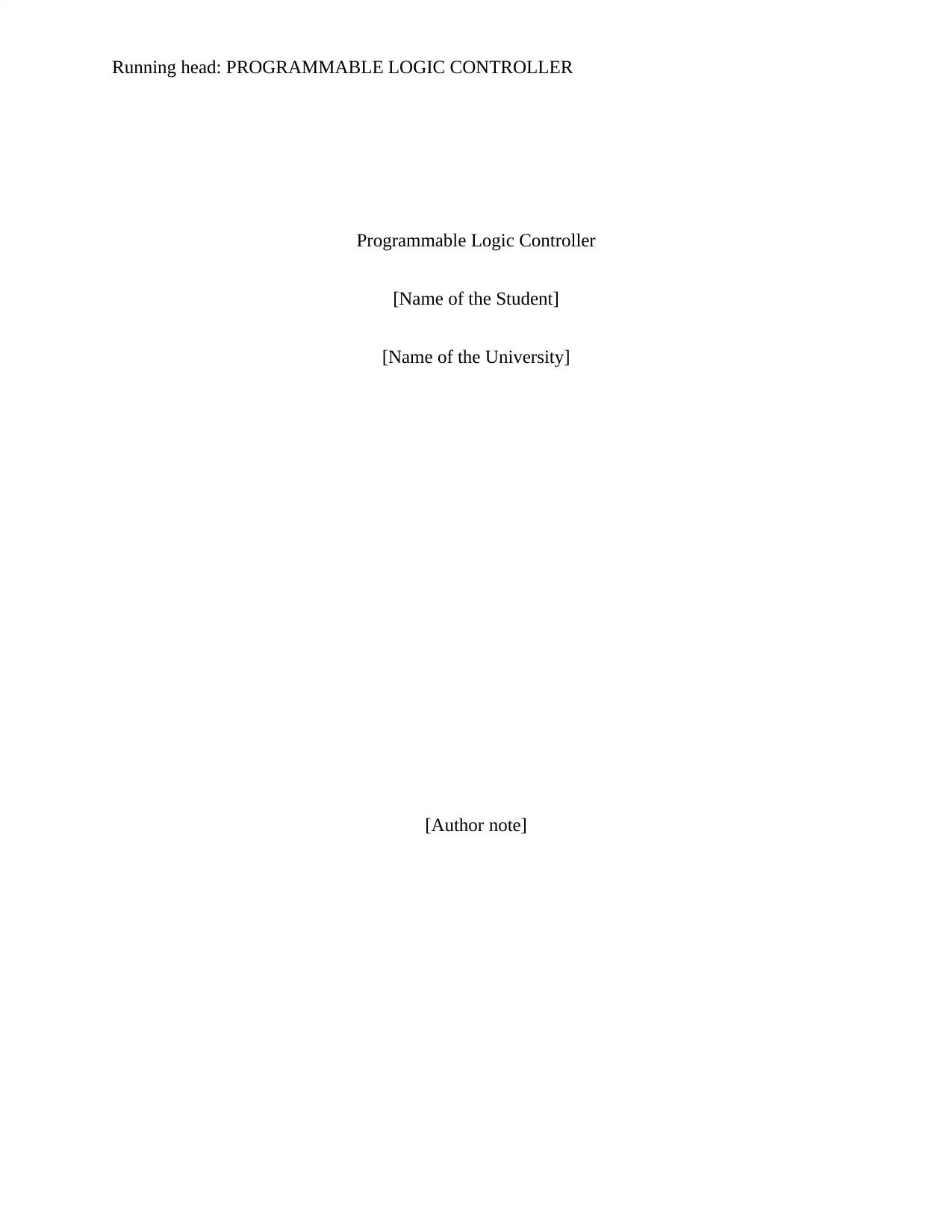
Running head: PROGRAMMABLE LOGIC CONTROLLER
Programmable Logic Controller
[Name of the Student]
[Name of the University]
[Author note]
Programmable Logic Controller
[Name of the Student]
[Name of the University]
[Author note]
Paraphrase This Document
Need a fresh take? Get an instant paraphrase of this document with our AI Paraphraser
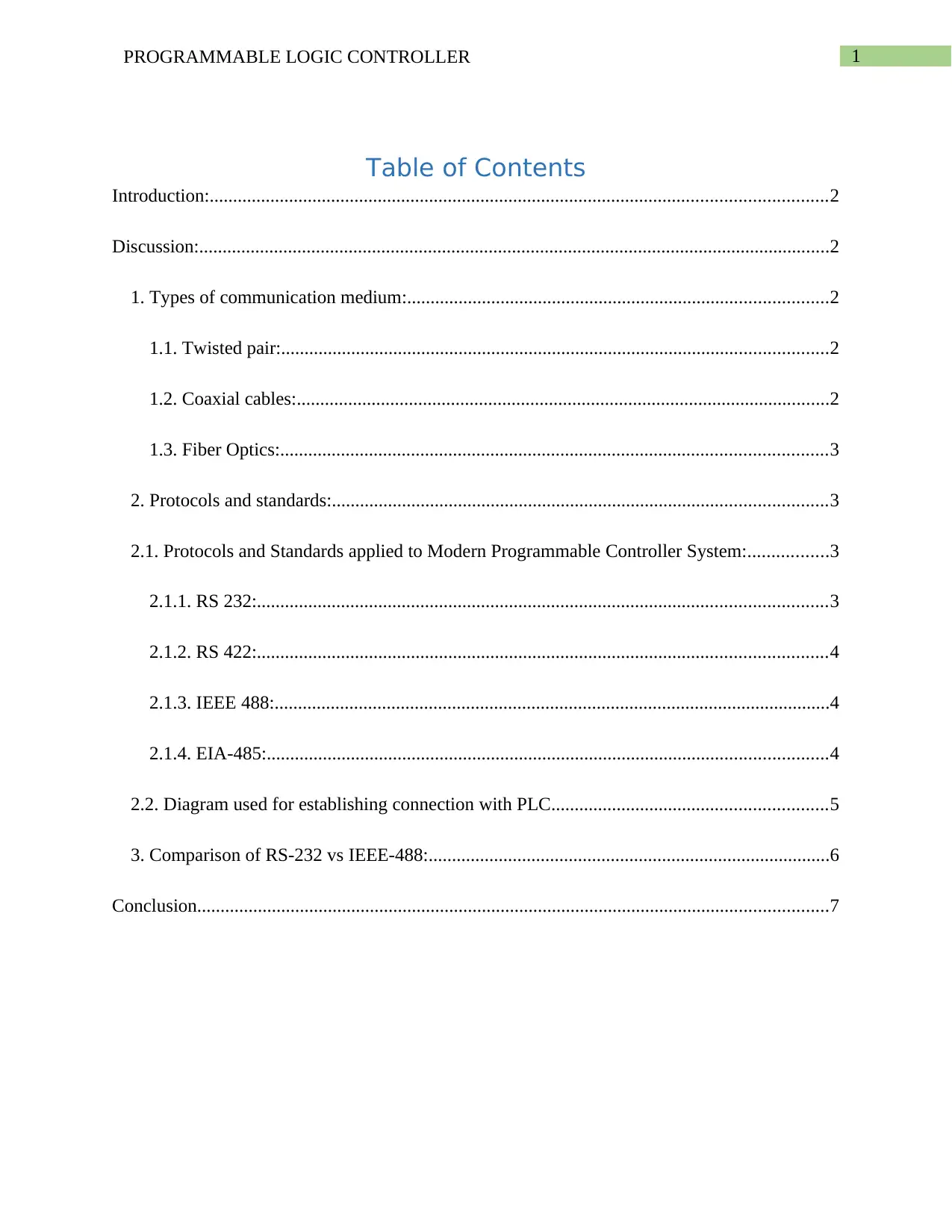
1PROGRAMMABLE LOGIC CONTROLLER
Table of Contents
Introduction:....................................................................................................................................2
Discussion:.......................................................................................................................................2
1. Types of communication medium:..........................................................................................2
1.1. Twisted pair:.....................................................................................................................2
1.2. Coaxial cables:..................................................................................................................2
1.3. Fiber Optics:.....................................................................................................................3
2. Protocols and standards:..........................................................................................................3
2.1. Protocols and Standards applied to Modern Programmable Controller System:.................3
2.1.1. RS 232:..........................................................................................................................3
2.1.2. RS 422:..........................................................................................................................4
2.1.3. IEEE 488:.......................................................................................................................4
2.1.4. EIA-485:........................................................................................................................4
2.2. Diagram used for establishing connection with PLC...........................................................5
3. Comparison of RS-232 vs IEEE-488:......................................................................................6
Conclusion.......................................................................................................................................7
Table of Contents
Introduction:....................................................................................................................................2
Discussion:.......................................................................................................................................2
1. Types of communication medium:..........................................................................................2
1.1. Twisted pair:.....................................................................................................................2
1.2. Coaxial cables:..................................................................................................................2
1.3. Fiber Optics:.....................................................................................................................3
2. Protocols and standards:..........................................................................................................3
2.1. Protocols and Standards applied to Modern Programmable Controller System:.................3
2.1.1. RS 232:..........................................................................................................................3
2.1.2. RS 422:..........................................................................................................................4
2.1.3. IEEE 488:.......................................................................................................................4
2.1.4. EIA-485:........................................................................................................................4
2.2. Diagram used for establishing connection with PLC...........................................................5
3. Comparison of RS-232 vs IEEE-488:......................................................................................6
Conclusion.......................................................................................................................................7
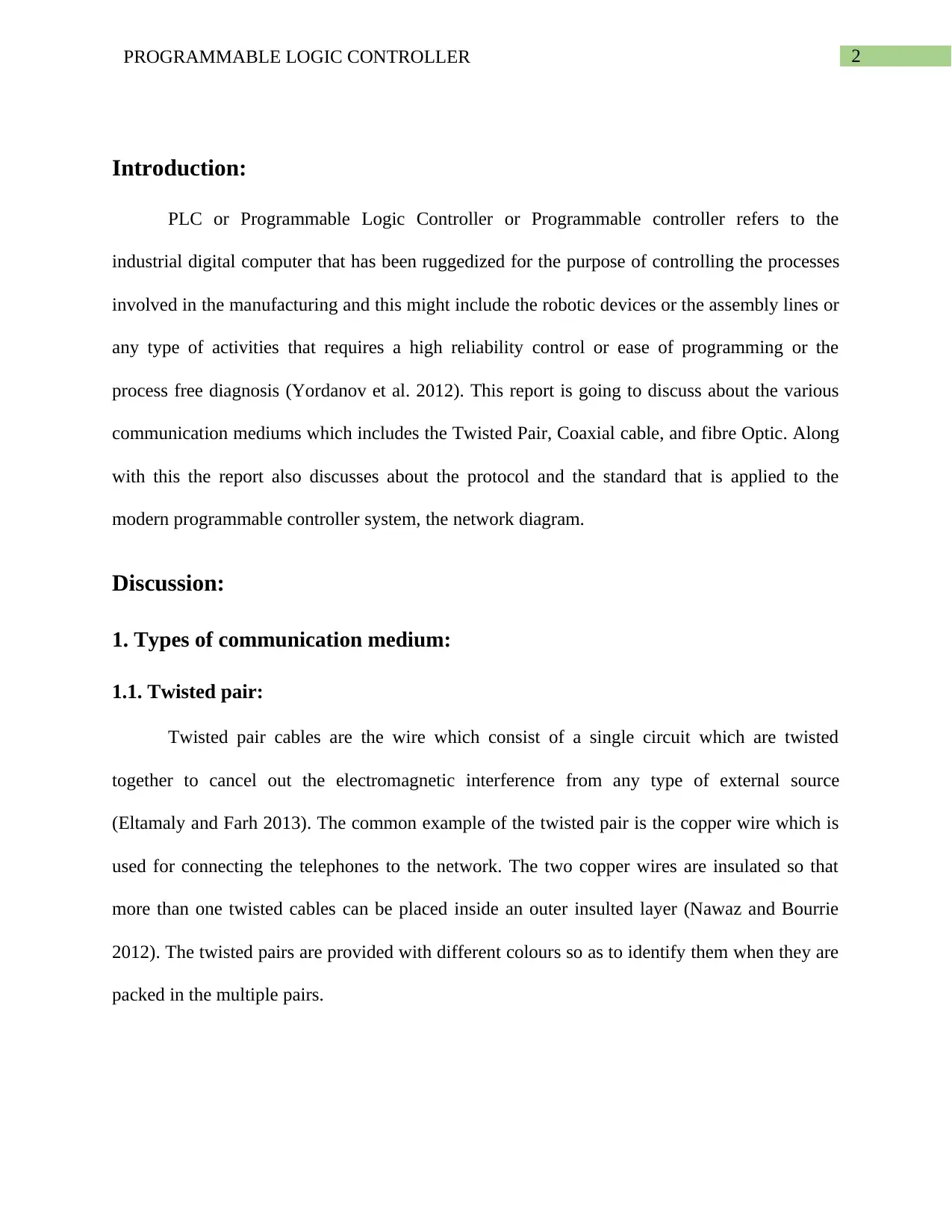
2PROGRAMMABLE LOGIC CONTROLLER
Introduction:
PLC or Programmable Logic Controller or Programmable controller refers to the
industrial digital computer that has been ruggedized for the purpose of controlling the processes
involved in the manufacturing and this might include the robotic devices or the assembly lines or
any type of activities that requires a high reliability control or ease of programming or the
process free diagnosis (Yordanov et al. 2012). This report is going to discuss about the various
communication mediums which includes the Twisted Pair, Coaxial cable, and fibre Optic. Along
with this the report also discusses about the protocol and the standard that is applied to the
modern programmable controller system, the network diagram.
Discussion:
1. Types of communication medium:
1.1. Twisted pair:
Twisted pair cables are the wire which consist of a single circuit which are twisted
together to cancel out the electromagnetic interference from any type of external source
(Eltamaly and Farh 2013). The common example of the twisted pair is the copper wire which is
used for connecting the telephones to the network. The two copper wires are insulated so that
more than one twisted cables can be placed inside an outer insulted layer (Nawaz and Bourrie
2012). The twisted pairs are provided with different colours so as to identify them when they are
packed in the multiple pairs.
Introduction:
PLC or Programmable Logic Controller or Programmable controller refers to the
industrial digital computer that has been ruggedized for the purpose of controlling the processes
involved in the manufacturing and this might include the robotic devices or the assembly lines or
any type of activities that requires a high reliability control or ease of programming or the
process free diagnosis (Yordanov et al. 2012). This report is going to discuss about the various
communication mediums which includes the Twisted Pair, Coaxial cable, and fibre Optic. Along
with this the report also discusses about the protocol and the standard that is applied to the
modern programmable controller system, the network diagram.
Discussion:
1. Types of communication medium:
1.1. Twisted pair:
Twisted pair cables are the wire which consist of a single circuit which are twisted
together to cancel out the electromagnetic interference from any type of external source
(Eltamaly and Farh 2013). The common example of the twisted pair is the copper wire which is
used for connecting the telephones to the network. The two copper wires are insulated so that
more than one twisted cables can be placed inside an outer insulted layer (Nawaz and Bourrie
2012). The twisted pairs are provided with different colours so as to identify them when they are
packed in the multiple pairs.
⊘ This is a preview!⊘
Do you want full access?
Subscribe today to unlock all pages.

Trusted by 1+ million students worldwide
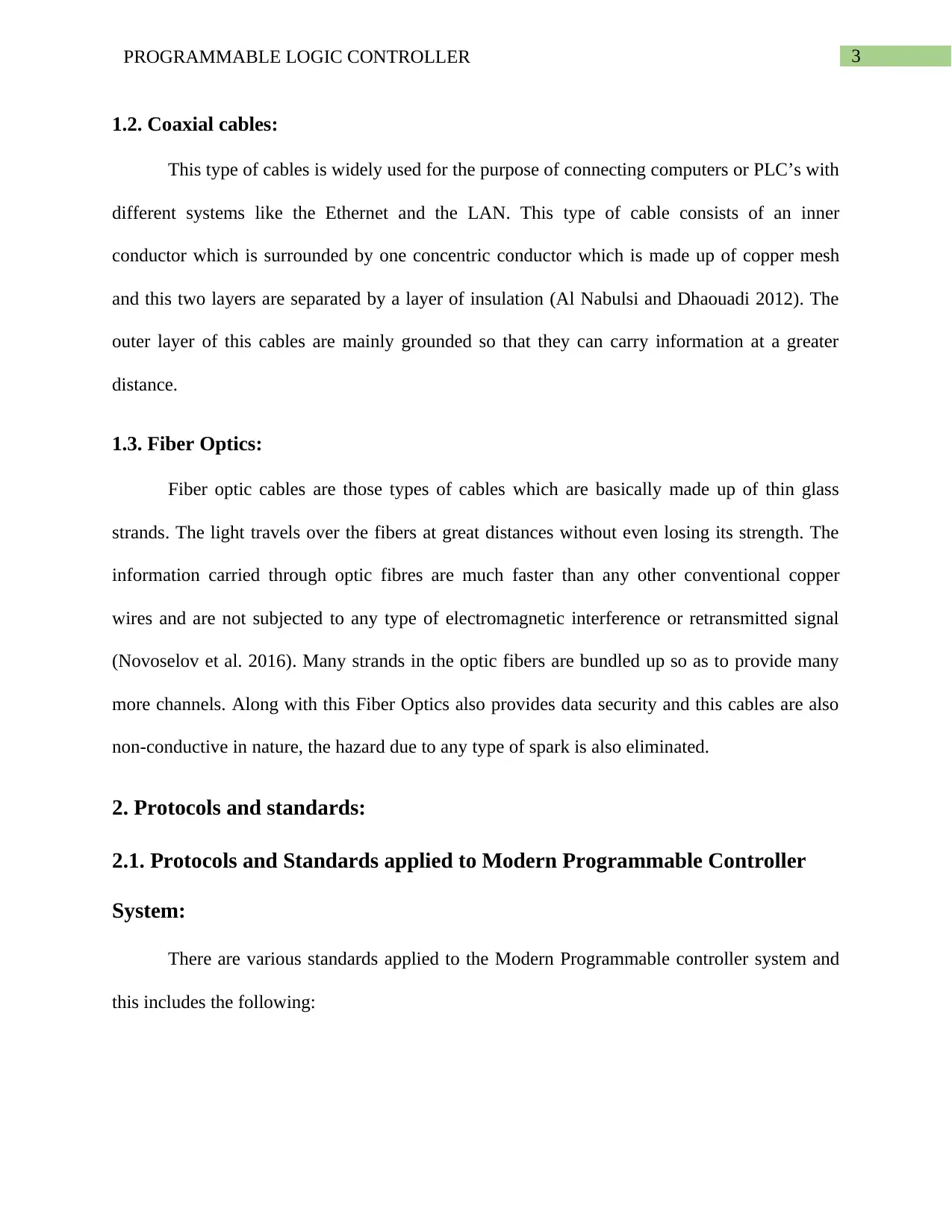
3PROGRAMMABLE LOGIC CONTROLLER
1.2. Coaxial cables:
This type of cables is widely used for the purpose of connecting computers or PLC’s with
different systems like the Ethernet and the LAN. This type of cable consists of an inner
conductor which is surrounded by one concentric conductor which is made up of copper mesh
and this two layers are separated by a layer of insulation (Al Nabulsi and Dhaouadi 2012). The
outer layer of this cables are mainly grounded so that they can carry information at a greater
distance.
1.3. Fiber Optics:
Fiber optic cables are those types of cables which are basically made up of thin glass
strands. The light travels over the fibers at great distances without even losing its strength. The
information carried through optic fibres are much faster than any other conventional copper
wires and are not subjected to any type of electromagnetic interference or retransmitted signal
(Novoselov et al. 2016). Many strands in the optic fibers are bundled up so as to provide many
more channels. Along with this Fiber Optics also provides data security and this cables are also
non-conductive in nature, the hazard due to any type of spark is also eliminated.
2. Protocols and standards:
2.1. Protocols and Standards applied to Modern Programmable Controller
System:
There are various standards applied to the Modern Programmable controller system and
this includes the following:
1.2. Coaxial cables:
This type of cables is widely used for the purpose of connecting computers or PLC’s with
different systems like the Ethernet and the LAN. This type of cable consists of an inner
conductor which is surrounded by one concentric conductor which is made up of copper mesh
and this two layers are separated by a layer of insulation (Al Nabulsi and Dhaouadi 2012). The
outer layer of this cables are mainly grounded so that they can carry information at a greater
distance.
1.3. Fiber Optics:
Fiber optic cables are those types of cables which are basically made up of thin glass
strands. The light travels over the fibers at great distances without even losing its strength. The
information carried through optic fibres are much faster than any other conventional copper
wires and are not subjected to any type of electromagnetic interference or retransmitted signal
(Novoselov et al. 2016). Many strands in the optic fibers are bundled up so as to provide many
more channels. Along with this Fiber Optics also provides data security and this cables are also
non-conductive in nature, the hazard due to any type of spark is also eliminated.
2. Protocols and standards:
2.1. Protocols and Standards applied to Modern Programmable Controller
System:
There are various standards applied to the Modern Programmable controller system and
this includes the following:
Paraphrase This Document
Need a fresh take? Get an instant paraphrase of this document with our AI Paraphraser

4PROGRAMMABLE LOGIC CONTROLLER
2.1.1. RS 232:
This standard is mainly for the interface and the protocol that is used for the purpose of
linking the computers to the electronic equipment’s of the industry (Guerriero et al. 2013). After
going through various updates the recent one is the RC232C.
2.1.2. RS 422:
This system is almost similar to that of the RS 232 but the only difference is that this type
of standard is preferred in transmission over long cables.
2.1.3. IEEE 488:
The main standard used in the parallel transmission is the IEEE 488.
2.1.4. EIA-485:
This standard was formerly known as the RS-485 or RS485 and is a standard used for the
serial communication of the 2 wires.
2.1.1. RS 232:
This standard is mainly for the interface and the protocol that is used for the purpose of
linking the computers to the electronic equipment’s of the industry (Guerriero et al. 2013). After
going through various updates the recent one is the RC232C.
2.1.2. RS 422:
This system is almost similar to that of the RS 232 but the only difference is that this type
of standard is preferred in transmission over long cables.
2.1.3. IEEE 488:
The main standard used in the parallel transmission is the IEEE 488.
2.1.4. EIA-485:
This standard was formerly known as the RS-485 or RS485 and is a standard used for the
serial communication of the 2 wires.

5PROGRAMMABLE LOGIC CONTROLLER
2.2. Diagram used for establishing connection with PLC
Fig 1
Source: (Created by Author)
2.2. Diagram used for establishing connection with PLC
Fig 1
Source: (Created by Author)
⊘ This is a preview!⊘
Do you want full access?
Subscribe today to unlock all pages.

Trusted by 1+ million students worldwide

6PROGRAMMABLE LOGIC CONTROLLER
Standard interface used for communication is IEEE-488 and it is also known as General Purpose
Instrument Bus (GBIP) (Papadopoulos, Chrysochos and Papagiannis 2013). The advantages and
disadvantage are described below:
Advantage
GPIB is a simple interface
GBIP has ports for interface which is widely available on the various test and
equipment’s for measurement.
GPIB cables are considered to be very rugged and provide robust connectors.
By making use of GPIB interface single controller can be analysed or checked.
It also provides control over various T & M equipment’s or devices.
Disadvantage
The connectors used in GPIB are considered to be bulky.
Interface generally carries low bandwidth of data.
GPIB interface is generally used for data communication at low speed whereas modern or
recent interface generally used for communication at high speed rate.
Current device has reduced its usage and it is expected that in coming years of the future
it can become isolated.
3. Comparison of RS-232 versus IEEE-488:
RS-232 communication is considered to be most popular or well-known method of PLC
which is used for external communication (Xia, Gupta and Antsaklis 2013). This particular
communication interface is considered to operate under SCADA mode of application. Other
Standard interface used for communication is IEEE-488 and it is also known as General Purpose
Instrument Bus (GBIP) (Papadopoulos, Chrysochos and Papagiannis 2013). The advantages and
disadvantage are described below:
Advantage
GPIB is a simple interface
GBIP has ports for interface which is widely available on the various test and
equipment’s for measurement.
GPIB cables are considered to be very rugged and provide robust connectors.
By making use of GPIB interface single controller can be analysed or checked.
It also provides control over various T & M equipment’s or devices.
Disadvantage
The connectors used in GPIB are considered to be bulky.
Interface generally carries low bandwidth of data.
GPIB interface is generally used for data communication at low speed whereas modern or
recent interface generally used for communication at high speed rate.
Current device has reduced its usage and it is expected that in coming years of the future
it can become isolated.
3. Comparison of RS-232 versus IEEE-488:
RS-232 communication is considered to be most popular or well-known method of PLC
which is used for external communication (Xia, Gupta and Antsaklis 2013). This particular
communication interface is considered to operate under SCADA mode of application. Other
Paraphrase This Document
Need a fresh take? Get an instant paraphrase of this document with our AI Paraphraser

7PROGRAMMABLE LOGIC CONTROLLER
standards are like RS422 and RS423 which are similar to this RS232 whereas they provide much
higher rates of transmission of data along with many longer cables.
Conclusion
From the above discussion it can be concluded that this report is all about different kinds
of communication media which is selected for a particular PLC, comparison between modern
PLC and a particular network has been described in details. Different type of communication
medium like twisted pair, coaxial cables, fiber optics, various protocol and standard has been
described in details in the above pages of the report. Four most common type of protocol that is
RS 232, RS422, IEEE 488, EIA-485 has been described in details in this report. A proper
diagram has been provided which is used for establishing connection various PLC has been
describe in this report briefly. Advantages and Disadvantages of IEEE-488 has been described in
details in this report. A proper discussion has been provided in the above pages regarding the two
standards that is RS-232 and IEEE-488.
standards are like RS422 and RS423 which are similar to this RS232 whereas they provide much
higher rates of transmission of data along with many longer cables.
Conclusion
From the above discussion it can be concluded that this report is all about different kinds
of communication media which is selected for a particular PLC, comparison between modern
PLC and a particular network has been described in details. Different type of communication
medium like twisted pair, coaxial cables, fiber optics, various protocol and standard has been
described in details in the above pages of the report. Four most common type of protocol that is
RS 232, RS422, IEEE 488, EIA-485 has been described in details in this report. A proper
diagram has been provided which is used for establishing connection various PLC has been
describe in this report briefly. Advantages and Disadvantages of IEEE-488 has been described in
details in this report. A proper discussion has been provided in the above pages regarding the two
standards that is RS-232 and IEEE-488.
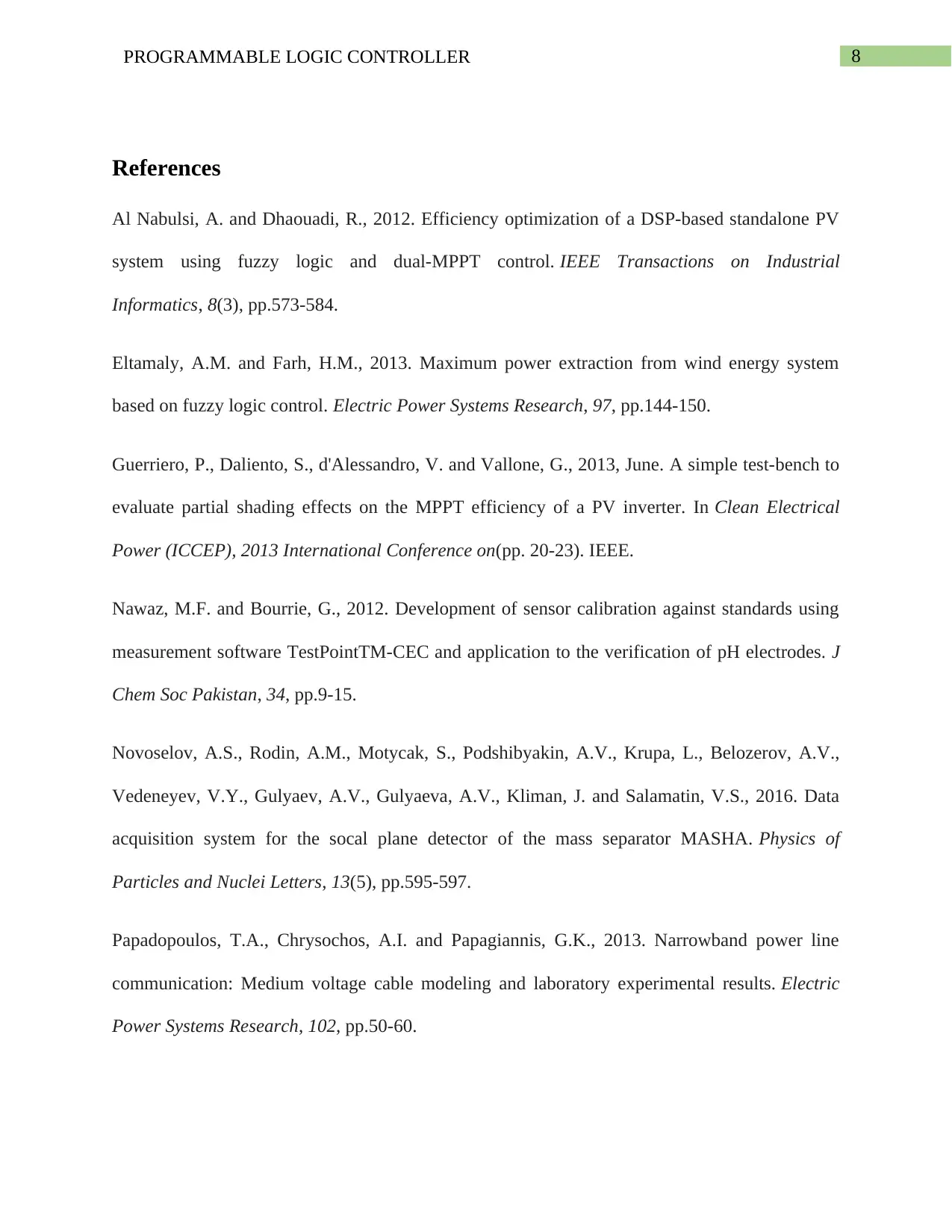
8PROGRAMMABLE LOGIC CONTROLLER
References
Al Nabulsi, A. and Dhaouadi, R., 2012. Efficiency optimization of a DSP-based standalone PV
system using fuzzy logic and dual-MPPT control. IEEE Transactions on Industrial
Informatics, 8(3), pp.573-584.
Eltamaly, A.M. and Farh, H.M., 2013. Maximum power extraction from wind energy system
based on fuzzy logic control. Electric Power Systems Research, 97, pp.144-150.
Guerriero, P., Daliento, S., d'Alessandro, V. and Vallone, G., 2013, June. A simple test-bench to
evaluate partial shading effects on the MPPT efficiency of a PV inverter. In Clean Electrical
Power (ICCEP), 2013 International Conference on(pp. 20-23). IEEE.
Nawaz, M.F. and Bourrie, G., 2012. Development of sensor calibration against standards using
measurement software TestPointTM-CEC and application to the verification of pH electrodes. J
Chem Soc Pakistan, 34, pp.9-15.
Novoselov, A.S., Rodin, A.M., Motycak, S., Podshibyakin, A.V., Krupa, L., Belozerov, A.V.,
Vedeneyev, V.Y., Gulyaev, A.V., Gulyaeva, A.V., Kliman, J. and Salamatin, V.S., 2016. Data
acquisition system for the socal plane detector of the mass separator MASHA. Physics of
Particles and Nuclei Letters, 13(5), pp.595-597.
Papadopoulos, T.A., Chrysochos, A.I. and Papagiannis, G.K., 2013. Narrowband power line
communication: Medium voltage cable modeling and laboratory experimental results. Electric
Power Systems Research, 102, pp.50-60.
References
Al Nabulsi, A. and Dhaouadi, R., 2012. Efficiency optimization of a DSP-based standalone PV
system using fuzzy logic and dual-MPPT control. IEEE Transactions on Industrial
Informatics, 8(3), pp.573-584.
Eltamaly, A.M. and Farh, H.M., 2013. Maximum power extraction from wind energy system
based on fuzzy logic control. Electric Power Systems Research, 97, pp.144-150.
Guerriero, P., Daliento, S., d'Alessandro, V. and Vallone, G., 2013, June. A simple test-bench to
evaluate partial shading effects on the MPPT efficiency of a PV inverter. In Clean Electrical
Power (ICCEP), 2013 International Conference on(pp. 20-23). IEEE.
Nawaz, M.F. and Bourrie, G., 2012. Development of sensor calibration against standards using
measurement software TestPointTM-CEC and application to the verification of pH electrodes. J
Chem Soc Pakistan, 34, pp.9-15.
Novoselov, A.S., Rodin, A.M., Motycak, S., Podshibyakin, A.V., Krupa, L., Belozerov, A.V.,
Vedeneyev, V.Y., Gulyaev, A.V., Gulyaeva, A.V., Kliman, J. and Salamatin, V.S., 2016. Data
acquisition system for the socal plane detector of the mass separator MASHA. Physics of
Particles and Nuclei Letters, 13(5), pp.595-597.
Papadopoulos, T.A., Chrysochos, A.I. and Papagiannis, G.K., 2013. Narrowband power line
communication: Medium voltage cable modeling and laboratory experimental results. Electric
Power Systems Research, 102, pp.50-60.
⊘ This is a preview!⊘
Do you want full access?
Subscribe today to unlock all pages.

Trusted by 1+ million students worldwide
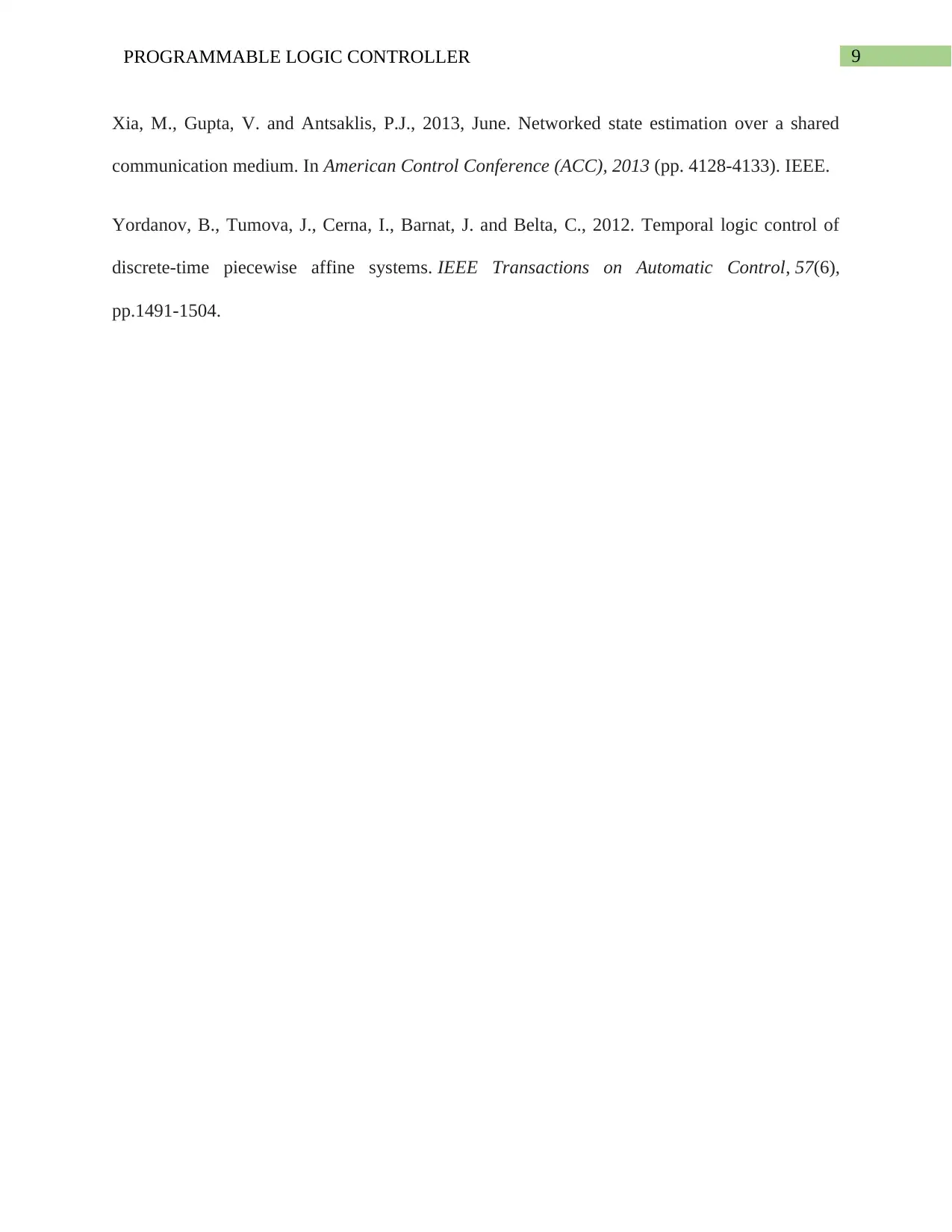
9PROGRAMMABLE LOGIC CONTROLLER
Xia, M., Gupta, V. and Antsaklis, P.J., 2013, June. Networked state estimation over a shared
communication medium. In American Control Conference (ACC), 2013 (pp. 4128-4133). IEEE.
Yordanov, B., Tumova, J., Cerna, I., Barnat, J. and Belta, C., 2012. Temporal logic control of
discrete-time piecewise affine systems. IEEE Transactions on Automatic Control, 57(6),
pp.1491-1504.
Xia, M., Gupta, V. and Antsaklis, P.J., 2013, June. Networked state estimation over a shared
communication medium. In American Control Conference (ACC), 2013 (pp. 4128-4133). IEEE.
Yordanov, B., Tumova, J., Cerna, I., Barnat, J. and Belta, C., 2012. Temporal logic control of
discrete-time piecewise affine systems. IEEE Transactions on Automatic Control, 57(6),
pp.1491-1504.
1 out of 10
Related Documents
Your All-in-One AI-Powered Toolkit for Academic Success.
+13062052269
info@desklib.com
Available 24*7 on WhatsApp / Email
![[object Object]](/_next/static/media/star-bottom.7253800d.svg)
Unlock your academic potential
© 2024 | Zucol Services PVT LTD | All rights reserved.




